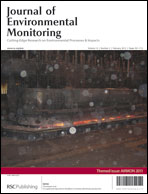Monitoring of heavy metal contaminants using feathers of shorebirds, Korea
Abstract
This study presents concentrations of iron, zinc, copper, lead and cadmium in the feathers of 3 shorebird species (n = 29) from Okgu Mudflat, Korea in the East Asian–Australian Migration Flyways. Lead concentrations (ANOVA, p < 0.001) in Red-necked Stints (geomean = 9.61 μg g−1 dry weight) were higher than in Terek Sandpipers (geomean = 5.56 μg g−1 dry weight) which in turn were higher than in Great Knots (geomean = 2.78 μg g−1 wet weight). Cadmium concentrations (ANOVA, p < 0.001) were higher in Great Knots (geomean = 2.97 μg g−1 wet weight) and in Red-necked Stints (geomean = 2.70 μg g−1 dry weight) than in Terek Sandpipers (geomean = 0.33 μg g−1 dry weight). Lead (r = 0.574, p < 0.01) and cadmium (r = 0.380, p < 0.05) concentrations between feathers and livers of shorebirds were significantly correlated. Lead concentrations in 65.5% (19 individuals) of shorebirds exceeded a toxicity threshold for feathers (4 μg g−1 dry weight). Iron, zinc, copper, lead and cadmium concentrations in feathers were within the range of earlier studies for wild birds, but lead concentrations in Red-necked Stints were higher than those reported in other studies. Because lead concentrations in feathers and livers of Red-necked Stints were markedly higher than in other shorebirds, we suggest that Red-necked Stints were exposed to higher lead concentrations than the other shorebirds on their breeding or wintering grounds.


 Please wait while we load your content...
Please wait while we load your content...